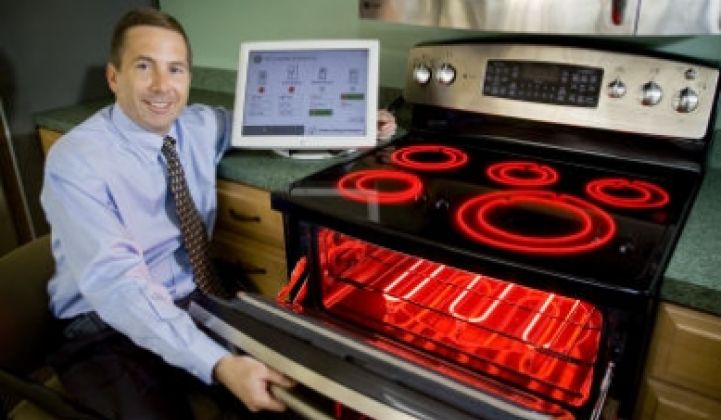General Electric has made a big deal about wanting smart grid systems to be based on open standards, and has said that its "smart" appliances – devices that can take commands from utilities or consumers to power down to save energy – will meet that commitment.
But when it comes to the finely tuned controls of GE's promised line of "smart" refrigerators, ovens and dryers, it's likely that GE's own Home Energy Manager system, unveiled Tuesday and planned for release early next year, will have better control over those appliances than systems from other companies (see GE Unveils Net Zero Energy Home Strategy).
That's according to Kevin Nolan, vice president of technology for GE's consumer and industrial division, who showed off GE's vision of a smart home of the future Tuesday at GE's Niskayuna, N.Y. global research center.
GE plans to start selling its home energy manager for between $200 and $250 some time next year, along with a "smart" thermostat to control home air conditioner and heating systems. As for its smart appliances, Nolan expects them to sell at roughly a $10 premium to traditional appliances, but the company hasn't set a hard date for their availability yet.
But while GE plans to make its appliances compatible with different home energy management systems, depending on which ones become popular with utilities and consumers, GE's own home energy manager would likely offer the most comprehensive controls, he said.
Smart appliances will work best when linked to systems integrated with the appliances' internal controls, he said. It will allow for such things as tiered power-down settings, rather than a simple on-off switch.
"There have got to be pre-approved modes" of operation, Nolan said. Simply turning a refrigerator on and off, for example, can lead to problems with the fridge's compressor, he noted. The same goes for the computers embedded in smart appliances, he said.
The fact that all appliances have to be approved by Underwriters Laboratories Inc., the organization that certifies the safety of consumer products, also limits GE's freedom to open up appliances to anyone who wants to tinker with how they work, he added.
The question then becomes: How will GE work with the host of companies developing home energy management systems of their own? The list includes startups such as Tendril Networks, Energate, Control4, Greenbox Technology and Onzo, as well as Google, Microsoft and Cisco (see stories here, here and here).
GE is working to integrate Tendril's home energy management software platform used by utilities to work with GE's appliances (see GE, Tendril Team Up on Smart Home Technology).
Whether or not GE is working with other home area network companies on a similar integration strategy, Nolan wouldn't say. But GE has a partnership with Google to explore a wide array of energy-related efforts (see Google and GE Gang Up for Green Energy), and Steve Fludder, vice president of GE's Ecomagination division, told Earth2Tech in February that the partnership could include work on a home energy management system.
As for which communications standards GE will use for its appliances and home energy manager, Nolan said the company was hoping to remain open to those that are reliable, secure and cost-effective.
But right now it's been working primarily on ZigBee and HomePlug, a power line carrier technology being developed to work with ZigBee, he said. That makes sense, given that ZigBee is emerging as the top choice for utilities to connect smart meters to home energy management systems (see RF Mesh, ZigBee Top North American Utilities' Smart Meter Wish Lists).
GE is also working with an FM radio data technology being developed by Radio Thermostat Co. of America and e-Radio (see The Latest Players in Smart Grid: Radio Stations), and is also looking at housing WiFi connections in its appliances, Nolan said.
At the same time, GE is thinking of making appliance communications systems modular, which would allow them to be able to be switched in and out depending on the utility's preferred systems, he said. The method is also being considered by a group called the U-SNAP Alliance (see U-SNAP: Modular Home Energy Communications).
Watching and waiting for a communications standard to emerge is something GE, Whirlpool and other appliance makers are contending with as they seek to bring smart appliances to market (see The Smart Appliance: Waiting For the Market to Choose Communications Standards).
As far as real-world tests of its products, utility Louisville Gas & Electric has tested out GE's appliances' ability to respond to the utility's signals to turn down power during peak demand times.
That pilot project didn't use GE's home energy manager, but the company is working on setting up other pilots that do, Nolan said.
Pictured above is Kevin Nolan, vice president of technology for GE's consumer and industrial division. Image via GE.



